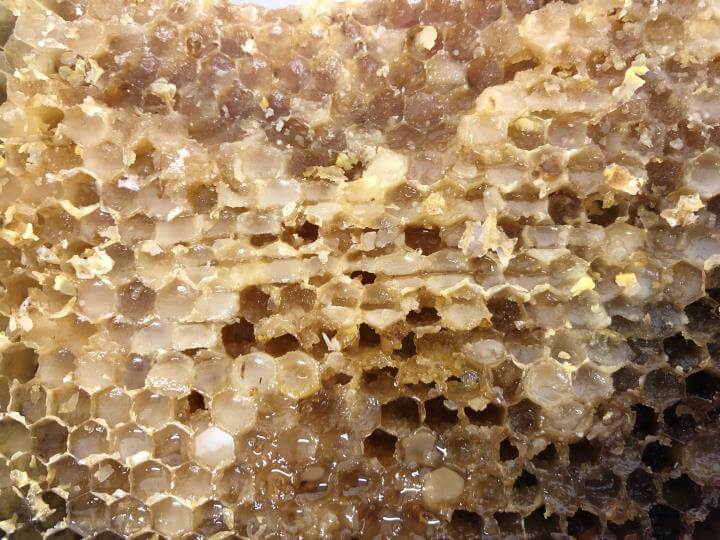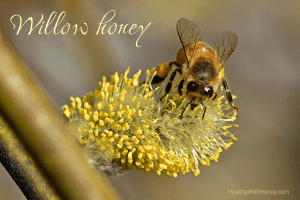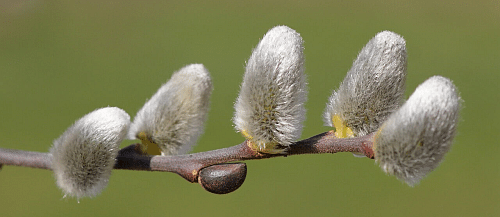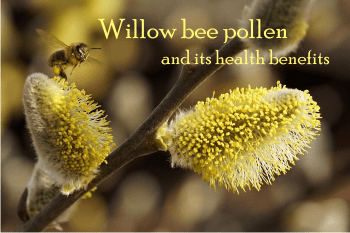Willow honey can be of two kinds, depending on its origin: from the nectar of the flowers and from the honeydew left on the bark by aphids.
Honey bees can make honey from all flowers with nectar. And if they can make it from coffee trees or cannabis, they can make it from willows. You would say willows don’t have flowers. I thought of this too, but the truth is that they do. It is true, however, that they don’t look like conventional flowers. But they appear early in the spring, before leaves, and we all know them as catkins.
Willows, belong to the genus Salix, which has around 350 species (plus numerous hybrids). Most species are known as willow, but some narrow-leaved shrub species are called osier, and some broader-leaved species are referred to as sallow.
Willows are trees and shrubs that grow naturally in moisture, along rivers and lakes, easily spotted due to their long branches with elongated leaves that hang down from the top, giving the impression of weeping all the time.
In early spring, the trees wake up to life and start with buds and flowers. Unusual flowers for a tree, also found in other trees like birches, chestnuts and hickories, called catkins. A cylindrical flower cluster with few to no petals, usually a few inches long and fuzzy, with an off-yellow color. During the spring, they are often mistaken for caterpillars once they have been pollinated and fallen off the tree.
Willows are dioecious, meaning the plants are either male or female. Catkins are erect, with 100-200 flowers in each female catkin and 200-300 flowers in each male catkin. Nectar is secreted from a single nectary projecting from the base of the flower.
Catkins are produced abundantly, with 5-10 on most terminal twigs; the total number of catkins on a single individual ranges from a few hundred on a bush growing in a crowded young population to several thousand on a well-spaced mature tree.
So, yes, plenty of nectar for the bees, as the flowers are pollinated not only by the wind, but also by bees and other insects. According to studies, female catkins produce much greater quantities of nectar per flower than male catkins: female flowers contained 46.1 ± 7.0 1.Lg and male flowers 16.0 ± 4.5 tag. Also, the nectar quantities appear to be greatest in the evening.
Being so early in the spring, catkins are important sources of nectar and pollen, especially for wild bees, such as bumble-bees and several species of Andrena, Collete and other solitary bees.
The pollen is not that nutritionally qualitative for honey bees, with a crude protein content between 20 and 25% only,. However, bees appreciate it as it is the only one available during this period of time.
How is willow honey?
Some studies have been made on the composition of willow honey from Poland, Croatia, Spain and New Zealand. Due to regional climate, differences in willow species, availability of other accompanying species for the bees, honey volatiles, even of the same floral origin, may vary from region to region.
- Willow from Poland had as main compounds of the extractives: vomifoliol (up to 39.6%) and methyl syringate (up to 16.5%) along with not common 4-hydroxy-3-(1-methylethyl)benzaldehyde (up to 11.1%). Abscisic acid (ABA) was found (up to 53.7 mg/kg) with the isomeric ratio (Z,E)-ABA:(E,E)-ABA=1:2. It exhibited low antioxidant potential. Polish honey was different to Spanish but similar to Croatian honey.
Phenolic compounds:
TPC (mg GAE/100 g)
Antioxidant activity:
DPPH, (mmol TEAC/kg): 2.1
FRAP, (mmol Fe(II)/Kg): 0.5
- Willow honey from Spain had in its composition: phenylacetaldehyde, benzaldehyde, methyl salicylate, 2,6,6-trimethylcyclohepta-2,4-dien-1-one as well as benzyl alcohol as the main volatile compounds.
- Willow from Croatia had phenylacetic acid, pinocembrin, 8-hydroxy-4,7-dimethylcoumarin and 3-hydroxy-trans-β-damascone as relevant volatile compounds.
Willow honeydew honey
- In New Zealand, willow honey is different. Due to the invasive pest found here, the Giant Willow Aphid (Tuberolachnus salignus). It excretes honeydew and is found in larger quantities than nectar, and honeybees prefer it. Unfortunately, the honey they made from it crystallizes in the comb, and this represents a significant loss to apiarists. It is difficult or non-cost-effective to extract by usual methods, thus reducing honey yield, and this affects apiarists in New Zealand, Switzerland, Australia and some other regions. Willow honeydew honey is, often termed “concrete honey”.
Why does willow honeydew honey crystallize so quickly?

As a rule, honeydew honey doesn’t crystallize quickly, it takes at least 1 year. Read more about it here: What is honeydew honey? But this type of honey has a different composition.
Generally, honey made from honeydew has a higher fructose/glucose ratio (F/G), lower total monosaccharide content (F + G; 45% cf. floral honey 60–80%), and higher di- and oligosaccharide content (8–30% cf. floral honey 3–10%), than most floral honeys (Pita-Calvo & Vázquez, 2017).
In willow honeydew honey the rapid crystalization is triggered by its high concentrations of oligosaccharides, particularly melezitose, which has an unusual saccharide linkages and crystallizes at a concentration between 8 and 22% (Howse, 2017, Imdorf et al., 1985).
Willow honeydew honey is not sweet.
The high melezitose content of the honey reduces its sweetness (Mussatto & Mancilha, 2007) and contributes to the unacceptable taste produced by the salicylic and malic acids that are considered reliable chemical markers for willow honeydew honey (Sopow, Jones, McIvor, McLean, & Pawson, 2017). Thus, its saleable value is reduced.
Does willow honeydew honey contain aspirin?
If honeydew is a liquid excreted by aphids from the willow bark, which contains a form of aspirin, wouldn’t the honey produced from it also contain it? This is a natural, logical question, but it starts with a distorted truth.
Willow bark doesn’t contain aspirin.
It contains low quantities of salicin, found more in some species, like Salix purpurea and Salix fragilis and salicylic acid. Salicin was named after the scientific name of the willow, Salix.
Both are found in the bark and leaves of willow and poplar trees, and even some other plants (like meadowsweet).
What is the relation between aspirin and salicin?
Aspirin, aka acetylsalicylic acid, is one of the most widely used drugs in the world and humankind’s oldest pharmaceutical agents. It can be toxic at high doses (greater than 150 milligrams per kilogram body weight), but the benefits of aspirin clearly outweigh the risks.
Salicylic acid is a plant hormone, an organic compound with the formula HOC6H4COOH. It’s colorless or white, with a bitter taste, and it is a precursor to and a metabolite of aspirin (acetylsalicylic acid).
Salicin → Salicylic acid →Acetylsalicylic acid
So, no, willow honeydew honey, though it originates from the willow’s bark, does not contain aspirin. At all.
**************************
References:
https://www.tandfonline.com/doi/pdf/10.1080/00063658509476853
https://pubmed.ncbi.nlm.nih.gov/33310258/
https://www.sciencedirect.com/science/article/abs/pii/S030881461301073X
Picture of concrete honey from Tasmania: https://nre.tas.gov.au/biosecurity-tasmania/plant-biosecurity/pests-and-diseases/giant-willow-aphid-and-concrete-honey




